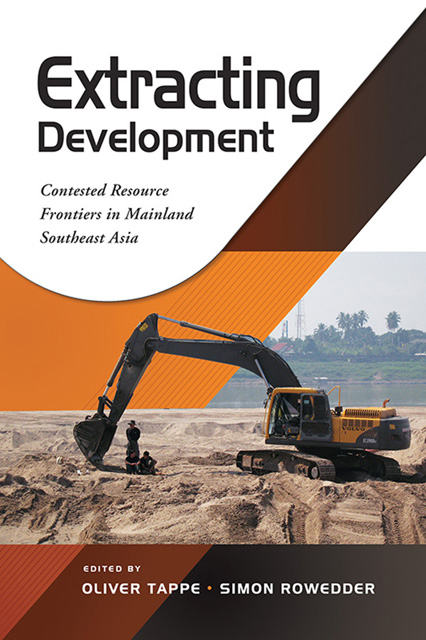Book contents
- Frontmatter
- Contents
- Acknowledgements
- The Contributors
- 1 Contested Resource Frontiers in Mainland Southeast Asia: An Introduction
- 2 Ontological Politics of the Resource Frontier: A Hydrosocial Analysis of the Mekong River in Northern Thailand
- 3 Reassembling Frontiers for Middle-Income Peasants: Rubber Expansion and Livelihood Ecosystem Transformation in a Northeast Thai Village
- 4 “Only the Best Fruits for China!”: Local Productions of a ‘Fruit Frontier’ in the Borderlands of China, Laos and Thailand
- 5 Commodity Frontiers in Motion: Tracing the Maize Boom across the Lao-Vietnamese Borderlands
- 6 New Frontier Spaces: Complex Entanglements and Power Relations (Re)shaping Land Governance in Laos
- 7 Moving Away from the Margins? How a Chinese Hydropower Project Made a Lao Community Modern and Comfortable
- 8 Frontier Capitalism in Colonial and Contemporary Laos: The Case of Tin Mining
- 9 Chinese Investments and Resource Frontiers in Cambodia: Systemic Transformation
- 10 The Open Issues: Cases between Chinese Investment Companies and Local People in Myanmar
- 11 Internationalization of RMB and Tin Ore Trade in China-Myanmar Frontier Governance: Views from Yunnan Province
- Index
4 - “Only the Best Fruits for China!”: Local Productions of a ‘Fruit Frontier’ in the Borderlands of China, Laos and Thailand
Published online by Cambridge University Press: 30 June 2023
- Frontmatter
- Contents
- Acknowledgements
- The Contributors
- 1 Contested Resource Frontiers in Mainland Southeast Asia: An Introduction
- 2 Ontological Politics of the Resource Frontier: A Hydrosocial Analysis of the Mekong River in Northern Thailand
- 3 Reassembling Frontiers for Middle-Income Peasants: Rubber Expansion and Livelihood Ecosystem Transformation in a Northeast Thai Village
- 4 “Only the Best Fruits for China!”: Local Productions of a ‘Fruit Frontier’ in the Borderlands of China, Laos and Thailand
- 5 Commodity Frontiers in Motion: Tracing the Maize Boom across the Lao-Vietnamese Borderlands
- 6 New Frontier Spaces: Complex Entanglements and Power Relations (Re)shaping Land Governance in Laos
- 7 Moving Away from the Margins? How a Chinese Hydropower Project Made a Lao Community Modern and Comfortable
- 8 Frontier Capitalism in Colonial and Contemporary Laos: The Case of Tin Mining
- 9 Chinese Investments and Resource Frontiers in Cambodia: Systemic Transformation
- 10 The Open Issues: Cases between Chinese Investment Companies and Local People in Myanmar
- 11 Internationalization of RMB and Tin Ore Trade in China-Myanmar Frontier Governance: Views from Yunnan Province
- Index
Summary
INTRODUCTION
China has been recording an ever-rising demand for tropical fruits (above all, durian) over the last two decades, particularly from Thailand. Besides China's growing affluent and consumption-oriented middle class, increasingly concerned about health and food safety, and travelling to tropical destinations in Southeast Asia and beyond, the elimination of tariffs for fruits and vegetables in 2003 within the scope of the ASEANChina Free Trade Area (ACFTA) contributed to this development. In 2017, China's import of fresh tropical fruits reached US$2.468 billion, up from US$1.378 billion in 2011 (Kubo and Sakata 2018, p. 1). Since 2002, ASEAN countries contributed more than 90 per cent of all tropical fruit imports to China (Lei 2018, p. 7), with Thailand increasingly competing with Vietnam and the Philippines. China's surging demand for Thai durian in particular is even undaunted by the COVID-19 pandemic. In the first four months of 2020, it imported from Thailand US$567.29 million worth of durians, 78 per cent more than in the same period of 2019 (Theparat 2020).
While most of the fruits are shipped by sea, with Shenzhen, Shanghai and Tianjin as the most important ports, overland transport through China's border provinces of Guangxi Zhuang Autonomous Region and Yunnan has grown significantly, particularly since the establishment of ACFTA. While most fresh fruit overland imports are shipped through Guangxi's Pingxiang Port on the border with Vietnam, “making it one of China's most significant entry ports for ASEAN member fresh fruit shipments” (GIZ 2020, p. 30), Yunnan's Mohan port on the China-Laos border, and, by extension, Laos have gained in importance. Since the opening of the Kunming-Bangkok Highway in 2008, which links the markets of China and Thailand through a 228-km section traversing Laos’ northwestern provinces of Luang Namtha and Bokeo, Yunnan province has been developing into an essential hub for imported Thai fruits. The opening of the 4th Thai-Lao Friendship Bridge in December 2013, linking Chiang Khong (Chiang Rai province, Thailand) and Huay Xai (Bokeo province, Laos) across the Mekong River, further boosted this development. Only by then, trucks did not need to take the timeconsuming and inconvenient ferry trips anymore.
- Type
- Chapter
- Information
- Extracting DevelopmentContested Resource Frontiers in Mainland Southeast Asia, pp. 79 - 105Publisher: ISEAS–Yusof Ishak InstitutePrint publication year: 2022



